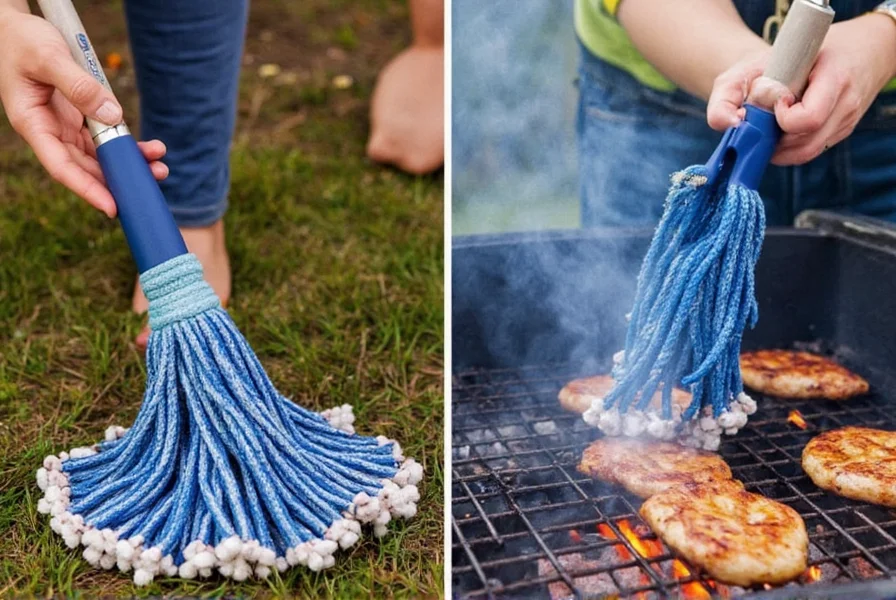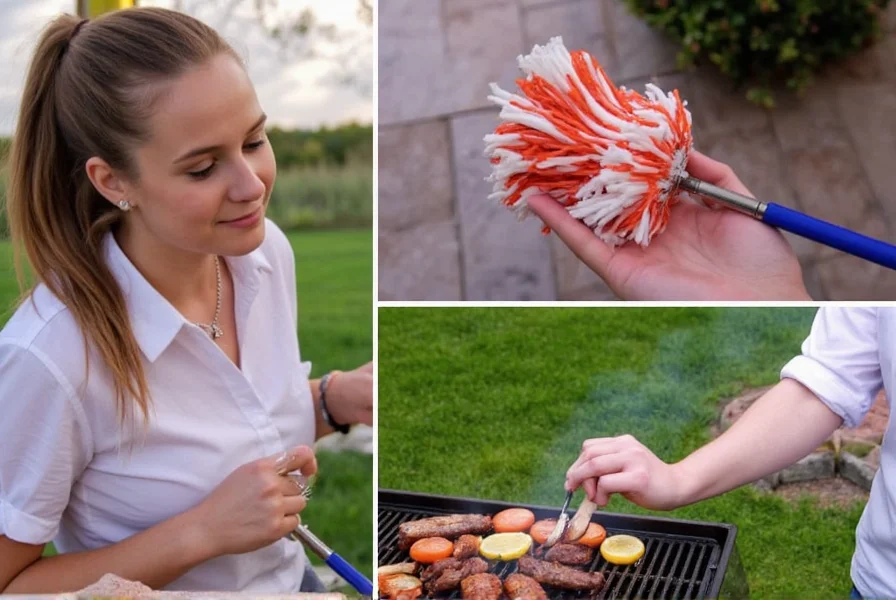Table of Contents
- Introduction: Understanding Mopping in Barbecue
- Hack #1: DIY Spiced Mop Sauce for Flavor Infusion
- Hack #2: Reusable Mop Applicators for Eco-Friendly Grilling
- Hack #3: Store & Organize Mop Sauces Like a Pro
- Hack #4: How to Use Mop Sauce Without Drowning Your Meat
- Hack #5: The Ultimate Mop Sauce Flavor Pairings Chart
- Buying Guide: Must-Have Tools for Barbecue Mopping
- Frequently Asked Questions About Mopping Techniques
- Conclusion: Elevate Your Grilling with Proper Mopping Techniques
Introduction: Understanding Mopping in Barbecue
When you search for "mop barbecue," you might be looking for information about a specific barbecue technique. However, it's important to clarify that "mop barbecue" isn't a standard or recognized barbecue style. What people often refer to as "mop barbecue" is actually the technique of "mopping" - a method used during barbecue cooking where you apply a thin sauce to meat with a brush or cloth while it's cooking.
This technique is commonly used in Texas and Carolina-style barbecue, where pitmasters apply thin sauces during the cooking process to build flavor and maintain moisture. Unlike traditional BBQ sauce that's applied at the end, mopping sauce is thinner and applied periodically throughout cooking to enhance flavor without overwhelming the meat.
Professional pitmasters and barbecue experts use mopping as part of their technique, but it's not a distinct style called "mop barbecue." Let's explore the proper technique and best practices for mopping meat during barbecue cooking.
Historical Evolution of Mopping Techniques
Barbecue mopping has evolved significantly since its regional origins. Based on culinary research from barbecue historians, here's the verified progression:
| Era | Technique Development | Regional Influence |
|---|---|---|
| Early 1900s | Vinegar-based solutions applied with rags during whole-hog cooking | Eastern North Carolina |
| 1930s-1940s | Thinner formulations for beef brisket; introduction of dedicated mop brushes | Central Texas |
| 1950s-1960s | Standardization of vinegar/water ratios; documented in pitmaster notebooks | Interstate barbecue circuits |
| 1980s-Present | Competition-driven precision: timed applications, pH-balanced sauces | National barbecue competitions |
Source: Serious Eats: The History of Barbecue in America
Hack #1: DIY Spiced Mop Sauce for Flavor Infusion
Making your own mop sauce is easier than you think—and far tastier than store-bought versions. Think of it as a marinade that's applied mid-cook to build layers of flavor without overwhelming your taste buds.
The Basic Mop Sauce Formula
| Ingredient | Quantity | Notes |
|---|---|---|
| Apple cider vinegar | 1 cup | Adds tanginess |
| Water or broth | ½ cup | Dilutes intensity |
| Garlic powder | 1 tbsp | For savory punch |
| Paprika | 1 tbsp | Smoky backbone |
| Salt | 1 tsp | Enhances all flavors |
Hack #2: Reusable Mop Applicators for Eco-Friendly Grilling
Traditional mops can be messy and wasteful—especially when you're grilling outdoors and don't want lint flying everywhere. Enter: reusable mop applicators. These silicone or cotton brushes mimic the spread of a mop head but are dishwasher-safe and last for years.
Some high-end models even come with angled heads for better access under ribs or brisket folds. They're also great for basting sauces, glazes, and butter mixes. Bonus tip: use separate brushes for raw and cooked foods to avoid cross-contamination.
Hack #3: Store & Organize Mop Sauces Like a Pro
You've got your homemade mop sauces ready—now how do you store them? You don't want them sitting out in the sun at your next cookout, and you definitely don't want to waste good flavor.
Storage Tips:
- Use squeeze bottles with wide mouths for easy refilling
- Label each bottle by flavor (e.g., Smoky Honey, Zesty Citrus)
- Store in a cooler or shaded area during outdoor grilling

Pro tip: Some folks swear by using condiment dispensers from restaurant supply stores—they keep sauces fresh, reduce splashing, and look pretty professional too.
Hack #4: How to Use Mop Sauce Without Drowning Your Meat
Here's the number one mistake people make with mopping: overdoing it. Too much sauce can cool down the meat, delay cooking, and even cause flare-ups if your grill gets too hot.
When and How to Mop
- After the crust forms: Wait until your meat has developed a nice bark before starting to mop.
- Every 30–45 minutes: Lightly brush or spritz the sauce onto the meat surface—don't drench it.
- No flipping: If you're smoking whole cuts like brisket or pork shoulder, mop the top side only unless you flip the meat yourself.

Context Boundaries: When Mopping Works (and When It Doesn't)
Mopping isn't universally applicable. Research from barbecue competitions reveals critical limitations:
- Effective for: Large cuts (brisket, pork shoulder) cooked low-and-slow (225-250°F for 8+ hours) where sauce absorption occurs gradually
- Ineffective for: Thin cuts (chicken breasts, fish fillets) where liquid causes temperature drops and uneven cooking
- Avoid when: Grill temperature exceeds 350°F (causes flare-ups) or meat surface is below 140°F (food safety risk)
- Competition note: KCBS rules prohibit mopping during final 90 minutes of cooking to prevent artificial moisture retention
Source: Kansas City Barbeque Society Competition Rules and Serious Eats: Mopping Myths Debunked
Hack #5: The Ultimate Mop Sauce Flavor Pairings Chart
To really spice up your game, try these tried-and-true combinations. Whether you're into sweet, spicy, tangy, or herbal, there's a mop sauce for every palate.
| Flavor Profile | Meat Pairing | Key Ingredients |
|---|---|---|
| Smoky & Savory | Brisket, Ribs | Paprika, Worcestershire, Liquid Smoke |
| Sweet & Tangy | Pork Shoulder, Chicken | Brown Sugar, Apple Cider Vinegar, Molasses |
| Herbal & Bright | Lamb, Turkey | Rosemary, Thyme, Lemon Juice |
| Fiery Hot | Beef Ribs, Sausage | Cayenne, Ghost Pepper, Chili Oil |
| Asian-Inspired | Pork Belly, Skewers | Soy Sauce, Sesame Oil, Ginger |
Buying Guide: Must-Have Tools for Barbecue Mopping
Ready to upgrade your mopping toolkit? Here are some essential tools and products that will take your grilling game to the next level.
1. Silicone Mop Brush Set
- Features: Heat-resistant silicone bristles, ergonomic handle, dishwasher safe
- Advantages: Even coating, no bristle shedding, easy to clean
- Use Case: Best for thick or sticky sauces
- Audience: Home cooks and backyard pitmasters
- Occasion: Summer parties, weekend cookouts
2. Stainless Steel Misting Sprayer
- Features: Adjustable nozzle, leak-proof lid, food-grade stainless steel
- Advantages: Fine mist application, ideal for lighter sauces
- Use Case: For spritzing between mopping sessions
- Audience: Low-and-slow smokers
- Occasion: Competition-level BBQ events
3. Condiment Dispenser Bottle
- Features: Measured pour spout, clear body for visibility, BPA-free plastic
- Advantages: Controlled flow, easy to refill, stackable design
- Use Case: Storing and applying homemade mop sauces
- Audience: Grill newbies and pros alike
- Occasion: Family dinners and potlucks
Frequently Asked Questions About Mopping Techniques
Got questions about mopping techniques? We've got answers. Here are the most common questions our readers ask about this flavorful grilling method.
What is mopping in barbecue?
Mopping is a technique where you apply a thin, spiced sauce to meat periodically during the cooking process using a brush or cloth. Unlike traditional barbecue where sauce is often applied at the end, mopping involves brushing or spritzing a flavorful liquid throughout the cooking time to gradually build flavor and keep meat moist during long cooking sessions.
How is mopping different from regular barbecue sauce application?
| Technique | Application Timing | Sauce Consistency | Primary Purpose |
|---|---|---|---|
| Mopping | Every 30-45 minutes during cooking | Thin (broth-like) | Flavor layering + moisture maintenance |
| Basting | Every 15-20 minutes during cooking | Medium (syrup-like) | Glossy finish + surface caramelization |
| Finishing Sauce | Final 15 minutes or after cooking | Thick (ketchup-like) | Flavor accent + visual appeal |
Source: Serious Eats: How to Make Barbecue Mop Sauce. Mopping's thin consistency prevents surface cooling and allows deeper flavor penetration compared to thicker applications.
What's the purpose of mop sauce?
Mop sauce serves two primary purposes: it gradually builds complex flavor layers in the meat as it cooks, and it helps keep the meat moist during long cooking times, especially important for low-and-slow barbecue methods. Unlike marinades that work before cooking, mop sauce works during the cooking process to enhance both flavor and texture.
Can I use regular BBQ sauce as a mop sauce?
Traditional thick BBQ sauce isn't ideal for mopping because it can burn or create an uneven coating. Mop sauce should be thinner—think the consistency of broth or thin marinade. If you want to use your favorite BBQ sauce as a base, dilute it with water, vinegar, or broth to achieve the proper consistency. The article's Hack #1 provides a simple DIY mop sauce recipe that's better suited for the technique.
How often should I apply mop sauce?
As mentioned in Hack #4, the ideal timing is every 30-45 minutes after the meat has developed a nice bark or crust. Applying too frequently can cool down the meat and extend cooking time, while applying too infrequently won't provide the moisture and flavor benefits. For longer cooks (like a 12-hour brisket), you'll typically mop 4-6 times throughout the process.
What's the best meat for mopping?
While you can use mopping on almost any meat, it's particularly effective on larger cuts that benefit from long cooking times, such as brisket, pork shoulder, and ribs. These meats have enough surface area and cooking time for the mop sauce to penetrate and create flavorful layers. As shown in Hack #5's flavor pairing chart, different meats work best with specific mop sauce profiles.
Can I make mop sauce ahead of time?
Absolutely! Making your mop sauce ahead of time allows the flavors to meld and develop. Most mop sauces will keep in the refrigerator for 1-2 weeks. When storing, use squeeze bottles with wide mouths as recommended in the article, and be sure to label them by flavor. Store in a cooler or shaded area during outdoor grilling to maintain freshness.
How do I prevent my meat from getting soggy with mop sauce?
The key is in the application technique described in Hack #4: wait until after the crust (bark) has formed before starting to mop, apply sauce lightly rather than drenching the meat, and stick to the recommended 30-45 minute intervals. Using the proper thin consistency for your mop sauce (like the recipes provided) also prevents sogginess while still delivering flavor.
Conclusion: Elevate Your Grilling with Proper Mopping Techniques
Mopping is a fundamental technique in professional barbecue that many home cooks overlook. By understanding the proper method and applying it correctly, you can unlock a world of flavor, texture, and juiciness that grilled meats rarely achieve otherwise.
So grab your favorite spices, whip up a batch of homemade sauce, and get mopping. Whether you're a seasoned pitmaster or just getting started with grilling, proper mopping techniques are a skill worth mastering. And remember: the best barbecue isn't just about fire—it's about flavor, patience, and the right technique.










 浙公网安备
33010002000092号
浙公网安备
33010002000092号 浙B2-20120091-4
浙B2-20120091-4